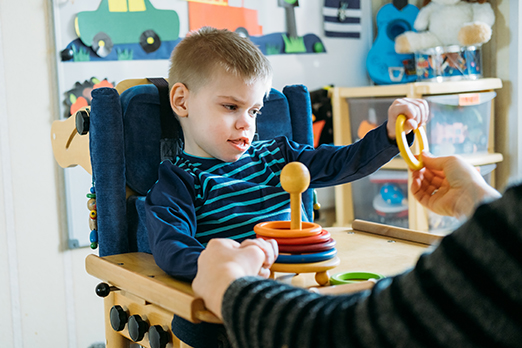Although Cerebral Palsy is not recognized as a specific disability under the USA federal law IDEA, the impact of this disorder may cause a student to be qualified for special education services to assist in accessing education.

What is It?
The U.S. National Library of Medicine defines Cerebral Palsy as a group of disorders that can involve brain and nervous system functions such as movement, hearing, seeing, thinking and learning. Damage to the brain occurs prior to birth or shortly after birth, while the brain is still developing. This can include any time during the first two years of a child’s life. Depending on which part of the brain is impacted, premature babies have a higher risk for developing Cerebral Palsy, which can be the result of bleeding in the brain, brain infections, head injury, lack of oxygen to a specific area of the brain, infections in the mother during pregnancy, and severe jaundice.
Cerebral Palsy (CP) can range from mild to severe. It is often described as a weakness and inability to make many voluntary movements and to stop or suppress involuntary ones. Individuals with CP may be unable to walk, due to the lack of muscle coordination, often have speech difficulty, and muscle spasms. Although the physical limitations vary, most people with CP are not intellectually disabled; they usually have normal intelligence.
There are between 500,000 to 700,000 Americans diagnosed with Cerebral Palsy, and about 1,500 children are born with it each day in the United States (Keller, 2005). About 1 in every 300 in the U.S. have Cerebral Palsy. The United Kingdom and Australia each estimate that about one in every 400 children are born with CP in their country.
Teaching Strategies
Many students have physical limitations and may need to use a wheelchair or other walking support. Without feeling comfortable in the environment, it is almost impossible to learn and be motivated to succeed. Classrooms should be arranged so there is ease of movement around chairs and desks. Physical challenges in speaking and writing can be supported by the use of technology such as recorders and computers which have made education much more accessible. Likewise, students can record lectures and later use a program such as “Dragon Dictation” to create their own notes for lectures, write stories, poems, research papers, and generally communicate more easily with teachers and friends.
References and Websites on this Subject
United States
ucp.org
cdc.gov
ipadcurriculum.com
United Kingdom
bupa.co.uk
patient.co.uk
scope.org.uk
Australia
cerebralpalsy.org.au
cpaustralia.com.au
cerebralpalsy.org.au
cerebralpalsy.org